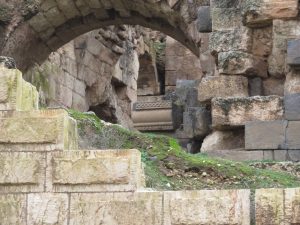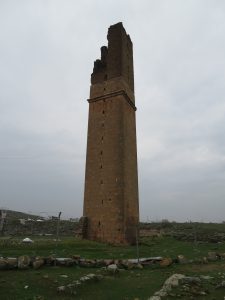
Sogmatar: white hills under an endless sky. At night, the view of the moon and the stars must be spectacular here, at Sogmatar. No doubt that the view is an important reason why humans with a religion following nature chose these hills for their temples: seven temples, each temple on a different hill. Visiting Sogmatar was an amazing experience, uncomparable to anything else.

The first sign of Sogmatar is the cave of Pognan. In the middle of nowhere, unprotected by any protection measure whatsoever, I find old carvings of humans against the walls of this cave. One assumption is that the human figures symbolize the planets, part of the religion of nature practiced here with a central place for the god Sin, the moon and the father of the gods. General knowledge so far relates Sogmatar directly to practices at Harran. Sogmatar could even have been Harran’s open-air temple.

After the cave, the road goes on to the hills. Poor houses are scattered around the place. Children approach to say hello. Do they not go to school? Yes they do, they say. They have a very old teacher and he is not giving lessons this afternoon. But there is a small building that forms the class room.

What should happen to these innocent children in the rather cruel environment of fundamentalists on the one side, and immense technological progress on the other? Can this half abandoned village prepare them for the world outside? I pass a goat, a dog and some garbage, to end up at the foot of a hill. On top of this hill lies the temple of the Sun or the central sacred hill (like in Harran, sources differ here so I can not give you precise information about what hill is what). The way to go up is rather easy, sport shoes would be nice but my boots with high heels do not create problems for the way up (and down).


Rock and earth, rock and earth: the higher one climbs the more impressive the view on the area becomes. Within ten minutes I arrive at the top of the hill. In front of me are new carvings made into the rocks of the hill, even better than the ones in the caves. Amazing: on top of this hill, for anyone to see and to visit, out in the open, a man and a woman are patiently looking at the new visitor. Maybe they didn’t see anybody for ages, but it could also be that I am visitor number 2 Million. However, the hills are totally deserted now, except of some villagers.


What I learned in my visit to Şanlıurfa – former byzantine town of Edessa – is that Syriac was a general language here. I always thought it was a religious language, used by minorities like the Syrian-Orthodox. However here it is found on mosaics, in Harran, and also here in Sogmatar where nothing indicates they ever heard about Christianity. It was in Syriac that astronomers studied their science, based on Syriac translations of old Greek texts of Aristotle and the like. It was in Syriac that they deployed their rituals towards the sun and the moon and the five planets Saturn, Jupiter, Mars, Venus and Mercury, each of them having their own temple on their own hill. From the hill of the temple of sun, all other hills are visible as you can see on the photographs.



Another hill that is visible on this picture (brown and green) looks like a place where excavations could be successful. I was told that some minor research was done on top of that hill and small stuff like coins were found there. One day, there will be archaeological excavations on this spot. It might be another Göbeklitepe. Let’s hope that whatever is under the surface will be safeguarded for future generations.

I pass the statues carved in the rock wall to go to the very top of the hill. The view is majestic. I imagine that it is night and that the sky shows all planets and stars in its full glory. There might not be a better location in Mesopotamia to watch than here. The builders of these temples either were Sabeans or were related to Sabeanism (see my other blog for uncertainties in sources about that). Holes in the top of the hill show that they had statues there, set upright by putting the smaller basis at the bottom of the statue into the hole. A man made basin indicates the spot where sacrifices were made.

More Syriac inscriptions are found on top of this hill. A translation: “I am Tridates, the son of Arab Governor Adona. I built this altar and pillar for Marelahe on February in 476, for the lives of my master King and his sons, for my father Adonna’s life, for my own life and for the lives of my siblings and my children”. The date of 476 written in the scripture means around 164-165 A.D. according to Seleucid calendar.

Technically speaking, there is ‘not so much to see’ here in Sogmatar. It is also not very old site, maybe 1800 years – not an impressive age in Mesopotamia. But for me, Sogmatar beats all other sites I visited in Şanlıurfa region for a reason I can not completely explain. I think one day I’d like to return and see what it feels like at night. Sogmatar echoes a lost religion of nature that survived much longer than generally known: most probably 800 to 1000 years after the introduction of Christianity and it had some kind of co-existence with Islam. Only the invasion of the Mongols put an end to this era.


On the way back to Şanlıurfa, I pass rock graves. Apparently, people did not just come here for religious and/or scientific practices but they also lived here. Stairs are leading into the rock graves that are empty. I look around, where did these people live? Wherever I look, the fields and hills are deserted except for the few houses close to the temples. The scenery does not reveal its secrets. It is in complete silence that I return to the city of Şanlıurfa – a very conservative-islam city where nothing echoes the lost religion of Sogmatar.
Interesting links, two blogs about Sogmatar:
http://unchartedruins.blogspot.com/2012/08/the-hall-of-records-temple-of-seven.html
http://www.sbresearchgroup.eu/Immagini/ReportfromSogmatar.pdf
To find your way in the region, read Traveling in Şanlıurfa





















